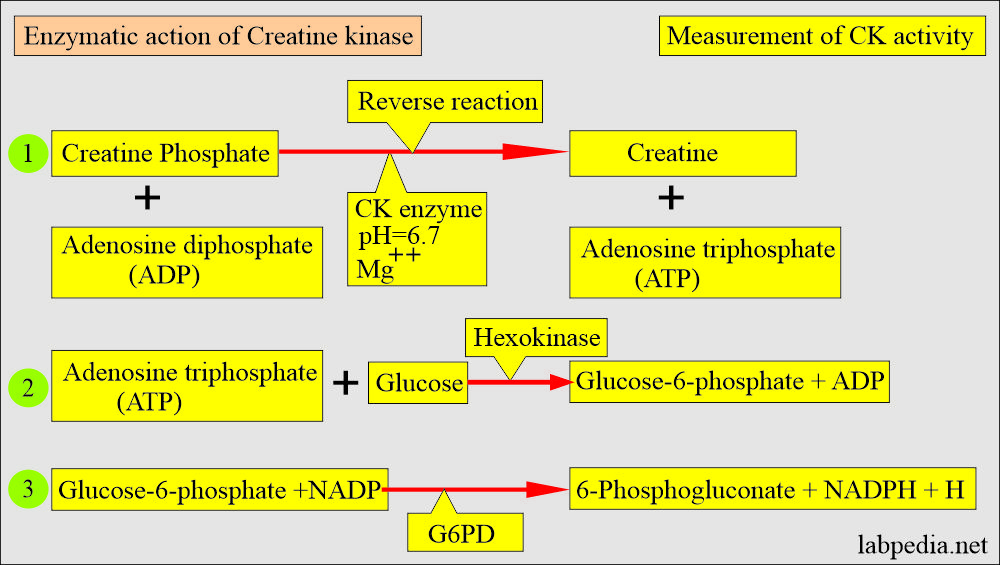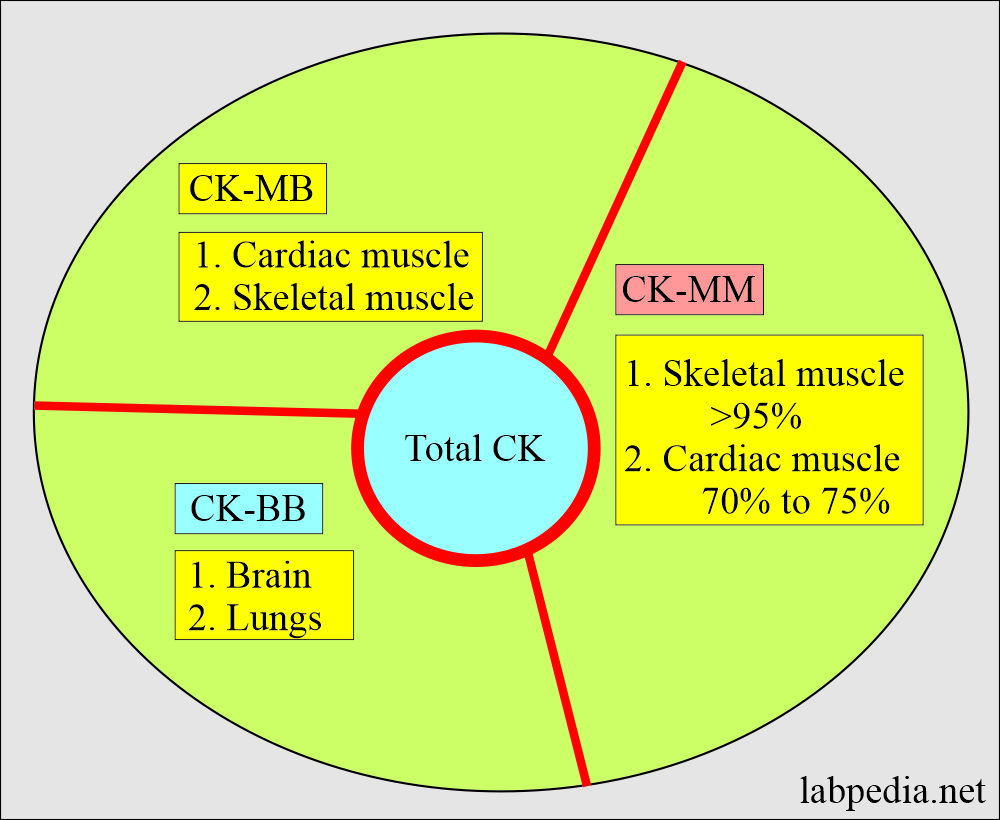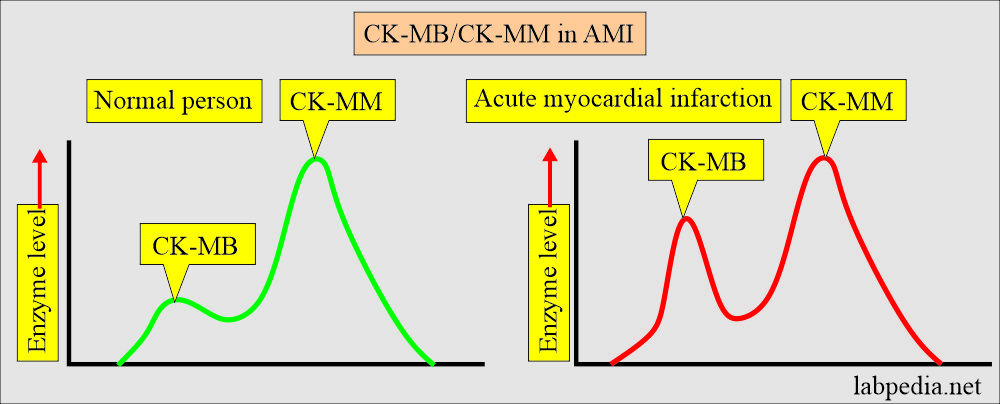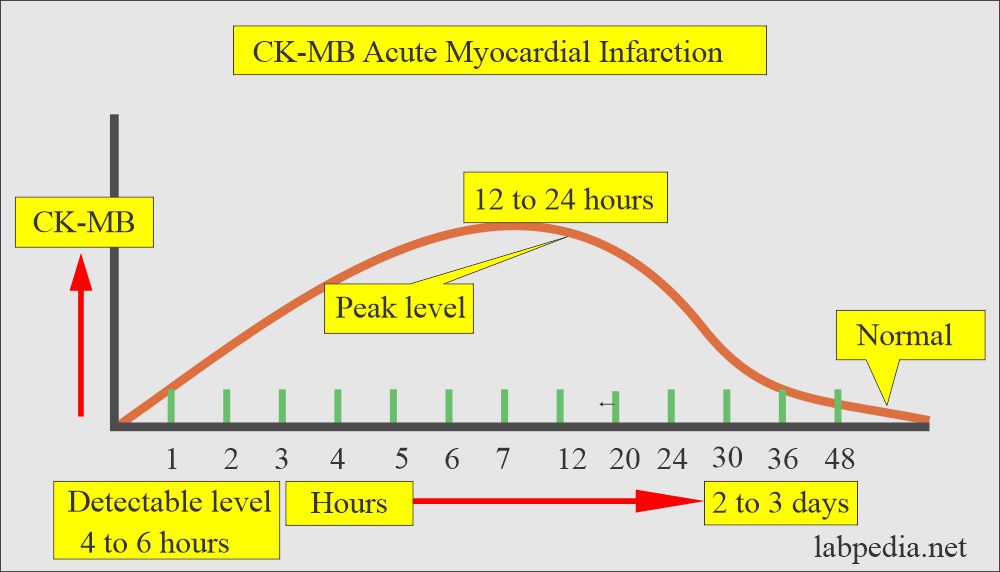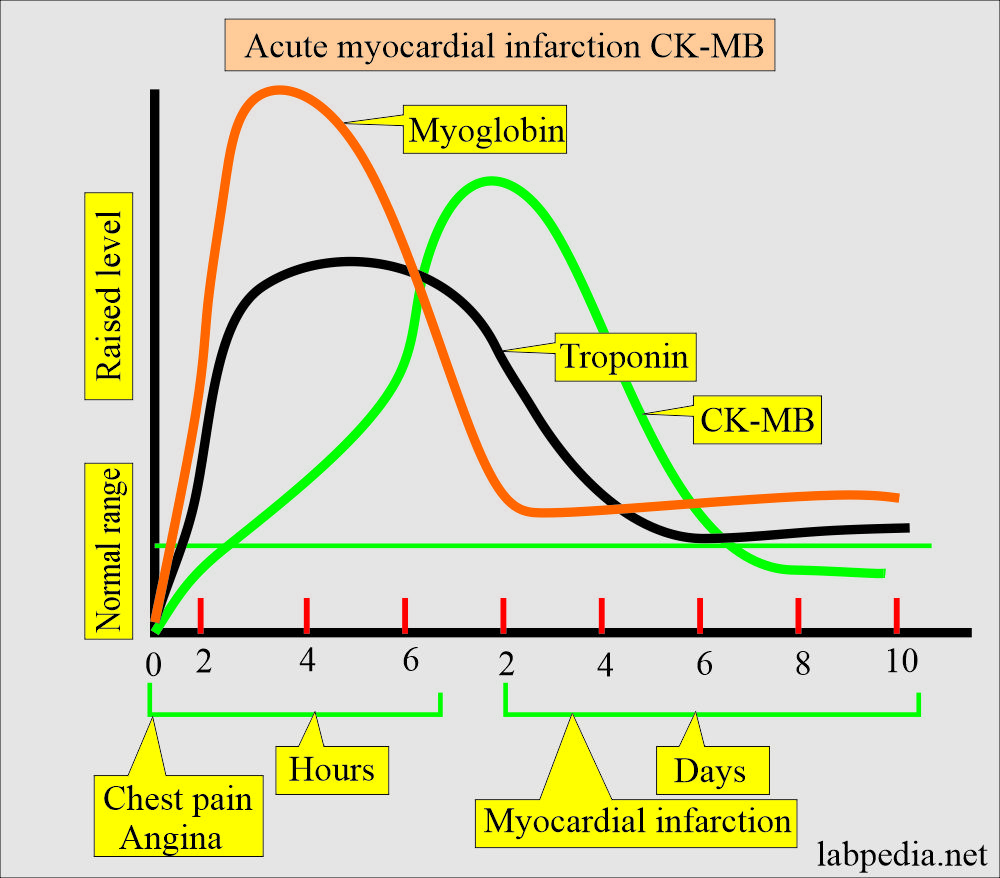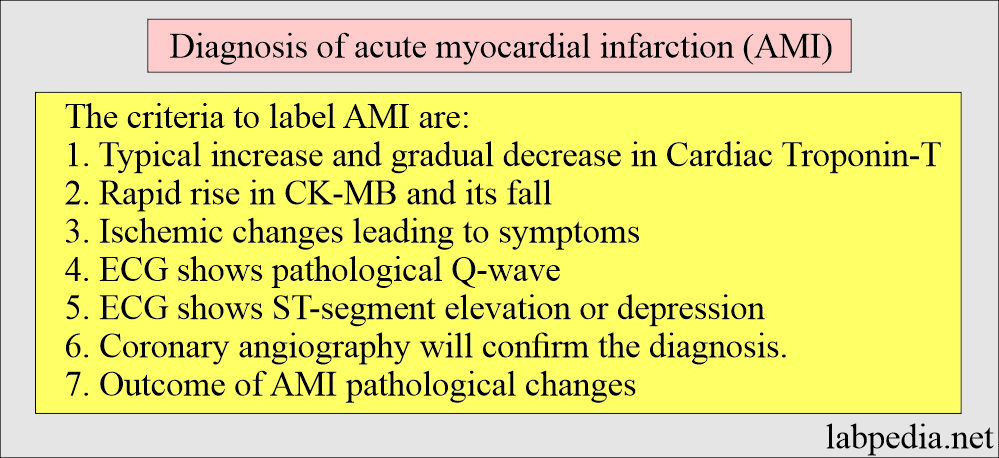Cardiac marker:- Part 2 – CK-MB (Cardiac Enzyme)
CK-MB
Sample for CK-MB
- The test is done in the serum (clotted blood 3-5 ml) of the patient.
- It also helps in quantifying myocardial muscle damage.
- The sample is stable for 4 to 8 hours at room temperature.
- 1 to 2 days at 4 °C.
- One month at -20 °C.
Purpose of the test (Indications) for CK-MB
- To diagnose myocardial muscle injury (MI).
- It is an early marker of acute myocardial infarction. This is considered an early gold-standard diagnostic tool.
- It Detects reinfarction or extension of myocardial damage after 72 hours.
- It is needed for reperfusion after thrombolytic therapy.
- This may replace troponins when advised within 24 hours of the onset of symptoms.
Precautions for CK-MB
- Avoid intramuscular injection with cardiac disease. I/M may raise the CK-MB level.
- Strenuous exercise and recent surgery may increase the CK-MB level.
- Early pregnancy may produce a decreased level of CK-MB.
- Drugs that may increase the level are alcohol, ampicillin, amphotericin B, aspirin, anesthetics, decadron, furosemide (Lasix), lidocaine, morphine, propanol, lithium, captopril, clofibrate, colchicine, and statins.
Definition of CK-MB
- CK-MB is an isoenzyme of Creatinine kinase.
- It is present in the cardiac muscles, skeletal muscles, and brain.
- CK-BB is found in the brain and nervous tissue; it is also found in the serum of newborn babies and malignancies showing embryonic tissue differentiation.
- The more rapid rise in CK-MB and fallback of the CK-MB marker of myocardial infarction.
Pathophysiology of CK-MB
- CK, creatine kinase; adenosine triphosphate:
- Creatine N-phosphotransferase is a dimeric enzyme with 82 kDa weight.
- It will catalyze the reversible phosphorylation of creatine by adenosine triphosphate (ATP).
- When muscle contracts, then ATP is converted into ADP (adenosine diphosphate).
- CK catalyzes the conversion of ATP to ADP using phosphocreatine (creatine phosphate) as the phosphorylation reservoir.
- Creatinine kinase comprises two polypeptide chains, B and M, making up three forms. These are the cytosolic enzymes.
- Distinct genes encode the M and B subunits.
- CK has isoenzymes:
- CK-1 =BB (CK-BB) = It is found predominantly in the brain and lungs.
- CK-2 =MB (CK-MB) = Predominantly found in the cardiac muscles.
- CK-MB is found mainly in the cardiac muscle, 25% to 30% of total myocardial CPK.
- Skeletal muscle contains a small fraction of CK-MB, 3% to 5%.
- CK-3 =MM (CK-MM) = It is found in the skeletal muscles.
Distribution of the creatinine kinase isoenzymes:
| Tissue where CK is found | CK-BB | CK-MB | CK-MM |
| Location in the body | Brain and lungs | Cardiac muscles | Skeletal muscles |
| Skeletal muscles (red fibers) | <1% | 3% | 97% |
| Skeletal muscles (white) | <1% | 1% | 99% |
| Brain | 100% | 0 | 0 |
| Heart | <1% | 22% | 78% |
| Smooth muscle GIT | 96% | 1% | 3% |
| Smooth muscle urinary bladder | 92% | 6% | 2% |
CK-MB significance:
- CK-MB is a cardiac marker released into the blood circulation when damage (necrosis) to the cardiac muscles occurs.
- CK-MB release into the blood circulation is detected within 6 to 18 hours of the onset of acute myocardial infarction.
- Because of the protein degradation mechanism that eliminates CK-MB from the blood circulation, because of this short window, the CK-MB peak level may be missed.
CK-MB role in the diagnosis of Acute Myocardial Infarction:
- It is specific for diagnosing cardiac muscle damage in the first few hours of Myocardial Infarction (MI).
- CK-MB is high in cardiac muscle and low in skeletal muscle, which is <3%.
- Around 10% of people have normal CK, while CK-MB is raised in myocardial infarction.
- This may be raised in skeletal muscle injury but not in injury due to injections and exercise.
- CK-Mb is not raised in the pulmonary embolism unless there is a heart muscle injury.
- In Duchenne’s muscular dystrophy, in the early stages, CK-MB is raised.
- CK-MB may be increased in patients with gangrene or severe ischemia of the limbs.
- If there is a persistent increase in CK-MB greater than 30 to 40% of the total CK indicates malignancy.
- CK-MB can be reported as:
- % of the total CPK = CK-MB/Total CPK.
- It can measure directly by immunoassay.
CK-MB relative index:
- This is done to avoid skeletal muscle injury with myocardial muscle damage.
- Calculation:
- CPK-MB/total CPK
- If CPK-MB = 3.0 ng/mL
- Relative index = ≥2.5
- This is highly suggestive of myocardial injury.
- If CPK-MB = >3.0 ng/mL
- Relative index = <2.5
- Not diagnostic for myocardial injury.
- If CPK-MB = 3.0 ng/mL
- CPK-MB/total CPK
CK-MB when begins to rise and interpretations:
- CK-MB begins to rise 3 to 6 hours after the onset of Acute Myocardial infarction (AMI).
- The peak is between 12 to 24 hours.
- It returns to normal in 24 to 48 hours.
- There is a rough correlation between the level of CK-MB and myocardial muscle damage.
- CK-MB After 72 hours of the AMI, 2/3 of the patients show an increase in CK-MB.
False-negative CK-MB results may be caused by the following:
- Poor sample timing, like only one sample in 24 hours.
- Sample <4 hours before the onset of AMI.
- Sample after >72 hours of AMI.
- A small infarct may not increase CK-MB level noticeably.
- Take the blood sample on admission or onset of acute chest pain immediately.
- Then repeat the sample at 6, 12, 18, and 24 hours afterward.
- Some of the hospitals repeat 3 samples, and some take 4 samples.
- 3 samples, take an immediate sample, and then at 12 and 24 hours.
- 4 samples, take an immediate sample, and then at 8, 16, and 24 hours.
- There is controversy about whether total CK or CK-MB level rises in the case of ischemia only.
- If you take LDH (isoenzyme) and CK-MB at the same time. The diagnostic specificity will increase.
- If an LDH blood sample is taken at 24 and 48 hours, while a CK-MB sample is taken immediately at 12 and 24 hours.
- In that case, the specificity of AMI reaches 95% or more.
- It reaches a peak in 12 to 24 hours.
- In one of the references:
- CK raised level in the first sample was 18%
- In the first 12 hours sample was 50%.
- In 24 hours sample was 4%.
- CK has not raised the level was 18%.
- Troponin is a more specific cardiac marker than CK-MB.
Disadvantages of CK-MB:
- Diagnosis can not be based on one sample value.
- Rapid return to normal CK-MB makes it a poor marker >72 hours after symptoms.
- CK-MB and total CK are decreased after cardiac surgery.
- A diagnosis of AMI can not be made until >12 to 24 hours after cardiac surgery.
- CK-MB and total CK can be increased in chronic disease and exercise.
- If CK-MB >20% or persists >48 to 72 hours considered atypical CK-MB.
Normal CK-MB
Source 1
- Normal = 5 to 25 IU/L
- Or it is 3 to 5% of Total CK.
- Single estimation is not reliable.
- Multiple samples are estimated for CK-MB.
Source 2
- CK – MB = 0 to 10 U/L
- CK – MB = 0 to 9 µg/L
- CK – MB by Immunoassay = <10 µg/L
- CK – MB On electrophoresis = <4 to 6%
Source 3
- CK-MB = 0 to 3 ng/mL
- Or o to 3 µg/L.
CK-MB and other cardiac enzymes:
| Enzyme | Start to raise hours | Peak (hours) | Days to normal |
| CK-MB | 4 | 18 | 2 |
| Total CPK | 4 to 6 | 24 | 3 to 4 |
| Troponin T | 4 to 6 | 10 to 24 | 10 |
| Troponin I | 4 to 6 | 10 to 24 | 4 |
| LDH | 24 | 72 | 8 – 9 |
| SGOT | 8 | 24 to 48 | 4 |
CK-MB may be raised in:
- Acute myocardial infarction.
- Cardiac aneurysmal surgery.
- Myocarditis.
- Ventricular arrhythmias.
- Duchenne’s muscular dystrophy.
- Patients with gangrene or severe ischemia of the limbs.
- Acute myositis of various types.
- Athletes who are long race runners.
- Idiopathic myoglobinemia.
- Reye’s syndrome.
- Rocky-spotted mountain fever.
CK-MB level is normal in:
- one study shows that CK-MB level is normal in:
- Myocarditis.
- Pericarditis.
- Subacute bacterial endocarditis.
- This is normal in patients undergoing defibrillation cardiac resuscitation unless there is cardiac muscle injury.
- If there is no muscular injury, then the CK-MB level is normal in angioplasty and coronary angiography.
- Please see more details in CK.
Questions and answers:
Question 1: What is the role of CK-BB?
Question 2: When CK-MB will be normal after the attack of AMI?

